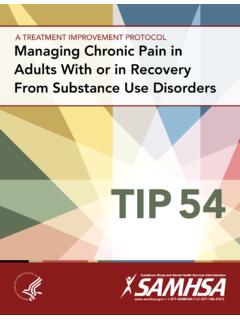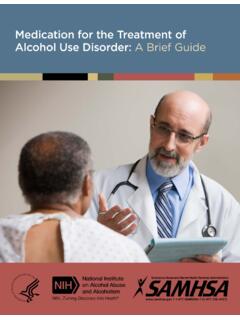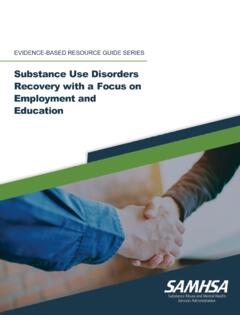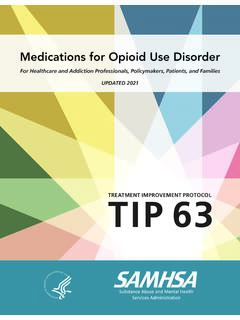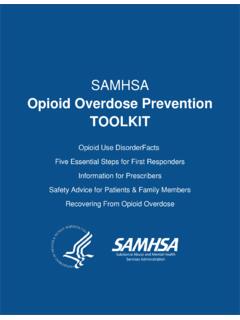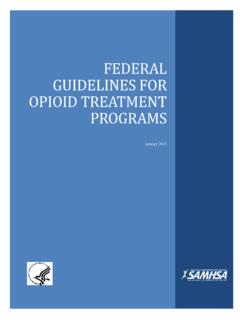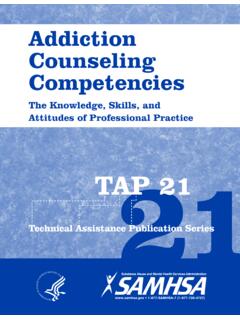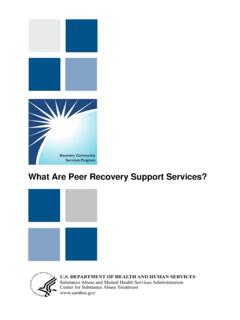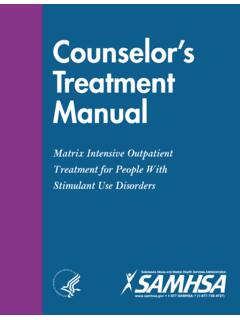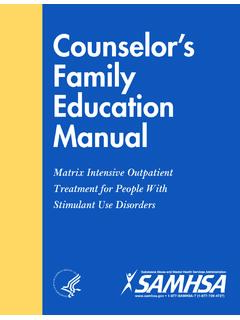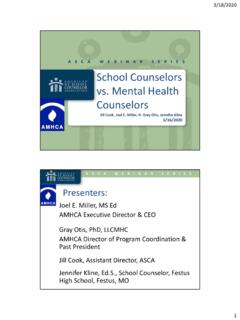Transcription of Substance Use and Suicide: A Nexus Requiring a Public ...
1 Behavioral Health Is Essential To Health Prevention Works Treatment Is Effective People Recover IN BRIEF 2016 Substance USE AND suicide : A Nexus Requiring A Public HEALTH APPROACH suicide is a serious and preventable Public health problem in the United States. Collaboration among prevention professionals across behavioral health fields has the potential to reduce suicide rates. While multiple factors influence suicidal behaviors, Substance use especially alcohol use is a significant factor that is linked to a substantial number of suicides and suicide attempts. This Nexus between Substance use and suicide provides an opportunity for behavioral health leaders to develop a cohesive strategy within a Public health framework to reduce suicidal behaviors and suicide rates.
2 This In Brief summarizes the relationship between Substance use and suicide and provides state and tribal prevention professionals with information on the scope of the problem, an understanding of traditional barriers to collaboration and current programming, and ways to work together on Substance misuse and suicide prevention strategies. Scope of the Problem Behavioral Health Is Essential To Health Prevention Works Treatment Is Effective People Recover 2 IN BRIEF How Prevalent Is Substance Misuse and suicide ? In 2013, there were more than 41,000 deaths as a result of suicide in the (CDC, 2015). suicide is the tenth leading cause of death, claiming more lives each year than death due to motor vehicle crashes.
3 It is the second leading cause of death for young people age 10 to 24, as well as for those age 25 to 42 (CDC, 2015). Additionally, almost four percent of adults million people age 18 or older had serious thoughts of suicide in the past 12 months, according to the National Survey on Drug Use and Health (NSDUH) (SAMHSA, 2014b). The prevalence of suicide ideation and suicide attempts varies based on demographic and individual factors, including age and Substance use. Within the adult population, million reported making a suicide plan, and million reported a suicide attempt (SAMHSA, 2015) suicide rates vary considerably within different population subgroups and are affected by factors such as socioeconomic status, employment, occupation, sexual orientation, and gender identity: Americans age 45 54 were more likely to die by suicide than any other single age group, with deaths per 100,000, compared to per 100,000 within the general population (CDC, 2015a); Adolescents and young adults (age 15 24) had a suicide rate of per 100,000, whereas suicide among children ages 5 14 was relatively rare per 100,000 in 2013 (CDC, 2015).
4 The rates of suicide were almost four times higher for men than for women ( per 100,000 vs. per 100,000) and were highest among Whites ( per 100,000) (CDC, 2015); and In 2013, suicide rates were per 100,000 for American Indians/Alaska Natives, per 100,000 for Asians/Pacific Islanders, per 100,000 for Hispanics, and per 100,000 for African Americans (CDC, 2015). Substance misuse is also prevalent in the among individuals age 12 and older in 2014: Approximately 1 in 12 ( million) had a Substance use disorder in the past year; Almost one quarter engaged in binge drinking in the past month; and Over 10 percent used illicit drugs in the past month (SAMHSA, 2015). At-Risk Populations for suicide The following populations are known to have an increased risk for suicidal behaviors (HHS, 2012): American Indians/Alaska Natives Individuals bereaved by suicide Individuals in justice and child welfare settings Individuals who engage in non-suicidal self-injury Individuals who have attempted suicide Individuals with medical conditions Individuals with mental and/or Substance use disorders LGBT individuals Members of the armed forces and veterans Men in midlife Older men Behavioral Health Is Essential To Health Prevention Works Treatment Is Effective People Recover Substance Use and suicide .
5 A Nexus Requiring a Public Health Approach 2016 3 Suicides and suicide Attempts Are Significantly Affected by Substance Use Individuals with Substance use disorders (SUDs) are particularly susceptible to suicide and suicide attempts. Indeed, suicide is a leading cause of death among people who misuse alcohol and drugs (SAMHSA, 2008; HHS, 2012; Wilcox, Conner, & Caine, 2004; Pompili et al., 2010). Substance misuse significantly increases the risk of suicide : Approximately 22 percent of deaths by suicide involved alcohol intoxication, with a blood-alcohol content at or above the legal limit (CDC, 2014b); Opiates (including heroin and prescription painkillers) were present in 20 percent of suicide deaths, marijuana in percent, cocaine in percent, and amphetamines in percent (CDC, 2014b).
6 One of the reasons alcohol and/or drug misuse significantly affects suicide rates is the disinhibition that occurs when a person is intoxicated (HHS, 2012; Pompili et al., 2010). Although less is known about the relationship between suicide risk and other drug use, the number of substances used seems to be more predictive of suicide than the types of substances used (HHS, 2012). However, the research on this subject is limited, and the relationship between drug misuse and suicide risk is even less developed. More research is needed on the association between different drugs, drug combinations, and self-medication on suicidal behavior (SAMHSA, 2008). Surveillance data nevertheless reveal that a diagnosis of alcohol misuse or dependence is associated with a suicide risk that is 10 times greater than the suicide risk in the general population, and individuals who inject drugs are at about 14 times greater risk for suicide (Wilcox, Conner, & Caine, 2004; SAMHSA, 2009).
7 Acute alcohol intoxication is present in about 30-40 percent of suicide attempts (Cherpitel, Borges, & Wilcox, 2004; SAMHSA, 2009). Many of these suicide attempts require medical attention, and every year about 650,000 people receive treatment in emergency rooms following a suicide attempt (Chang, Gitlin, & Patel, 2011). In 2011, approximately 230,000 emergency department visits resulted from drug-related suicide attempts, and almost all involved a prescription drug or over-the-counter medication. The number of emergency department visits for drug-related suicide attempts increased 51 percent overall from 2005 to 2011, and more than doubled among people age 45 64 (SAMHSA, 2014a). The text box on page 4 provides some additional information regarding alcohol s role in suicidal behavior.
8 Behavioral Health Is Essential To Health Prevention Works Treatment Is Effective People Recover 4 IN BRIEF Alcohol s Behavioral Mechanism as a Catalyst for suicide Acute alcohol intoxication may substantially increase the risk of suicide by decreasing inhibitions and increasing depressed mood. The acute effects of alcohol intoxication act as important proximal risk factors for suicidal behavior among individuals with alcohol use disorders and those without. Mechanisms responsible for alcohol s ability to increase the proximal risk for suicidal behavior include alcohol s ability to (1) increase psychological distress, (2) increase aggressiveness, (3) propel suicidal ideation into action through suicide -specific alcohol expectancies ( , alcohol may supply the motivation to complete the action, the user may believe that alcohol will assist in completing suicide painlessly), and (4) constrict cognition, which impairs the generation and implementation of alternative coping strategies (Hufford, 2001).
9 Programs that Address the Substance Use/ suicide Nexus SAMHSA s National Registry for Evidence-based Programs and Practices (NREPP) and the suicide Prevention Resource Center s (SPRC s) Best Practices Registry include evidence-based programs that focus on Substance misuse and suicide prevention in different settings (see Resources). The text box below summarizes three programs that specifically target adolescents and their caregivers. Many of these programs contain replicable elements , life skills training that support effective problem-solving and emotional regulation, the nurturing of positive connections with friends and family members, and strong ties to both school and community.
10 Taken together, these social supports can protect individuals from both Substance use and suicide . Other programs provide treatment and recovery support and help guide the individual toward recovery from SUDs and from preoccupations with suicidal thoughts. A Sampling of Evidence-Based Programs for Adolescents and Their Caregivers Model Adolescent suicide Prevention Program (MASPP) uses a Public health-oriented suicidal-behavior prevention and intervention program originally developed for a Native American tribe in New Mexico. The goals of the program are to reduce the incidence of suicides and suicide attempts by adolescents through community education about suicide and related behavioral issues that include alcohol and Substance misuse.
